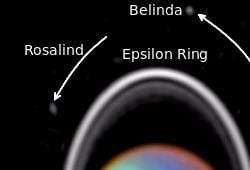Discovery date January 13, 1986 Eccentricity 0.00011 ± 0.000103 Discovered 13 January 1986 | Mean orbit radius 69,926.795 ± 0.053 km Orbital period 13 hours | |
 | ||
Inclination 0.27876 ± 0.045° (to Uranus' equator) Similar Stephen P Synnott discoveries, Uranus moons, Other celestial objects | ||
Rosalind (/ˈrɒzəlᵻnd/ ROZ-ə-lind) is an inner satellite of Uranus. It was discovered from the images taken by Voyager 2 on 13 January 1986, and was given the temporary designation S/1986 U 4. It was named after the daughter of the banished Duke in William Shakespeare's play As You Like It. It is also designated Uranus XIII.
Rosalind belongs to Portia group of satellites, which also includes Bianca, Cressida, Desdemona, Portia, Juliet, Cupid, Belinda and Perdita. These satellites have similar orbits and photometric properties. Other than its orbit, radius of 36 km and geometric albedo of 0.08 virtually nothing is known about Rosalind.
In the Voyager 2 images Rosalind appears as an almost spherical object. The ratio of axes of Rosalind's prolate spheroid is 0.8-1.0. Its surface is grey in color.
Rosalind is very close to a 3:5 orbital resonance with Cordelia.
